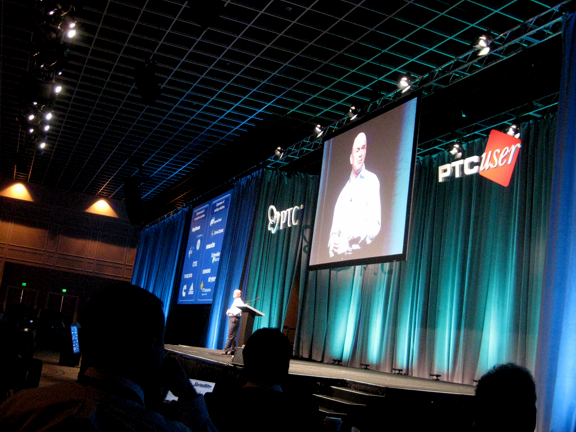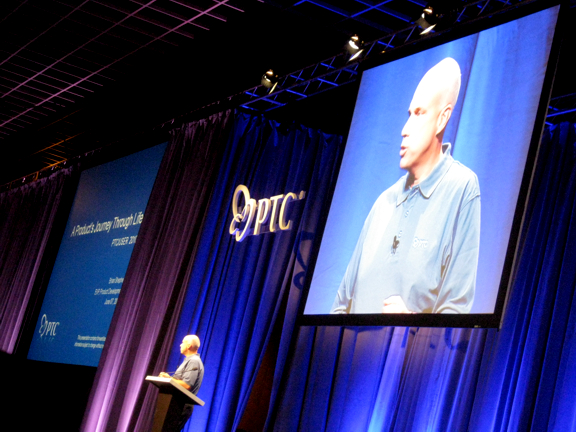Latest News
June 8, 2010



Jim Heppelmann, PTC’s CEO-elect, thinks CAD has become “less exciting.” He plans to energize the industry with a new offering, a family of products presently known only as Project Lightning.
On Monday June 7, the first day of this year’s PTC User World Event (Orlando, Florida), when Heppelmann addressed the crowd inside Rosen Shingle Creek hotel’s 95,000 sq. ft. ballroom, he said, “[most CAD releases are] characterized by ongoing refinements to user interfaces, new modules, and so forth ... There hasn’t been a revolutionary departure since Sam Geisberg’s innovation of 1985 [founder of PTC, credited with developing the first commercially marketed parametric CAD program].”
If you say, the dust has settled in CAD frontier because it’s a mature market, Heppelmann would ask, rhetorically, “How can it be a mature market if it still has such big unsolved problems?” He pointed to three issues as symptoms of market lethargy: usability, interoperability, large assembly management.
“It’s very difficult for a casual user to pick up SolidWorks, Inventor, or Pro/ENGINEER and start working with it. When I think of easy-to-use [products], I’m thinking Visio, Google SketchUp; I’m thinking of something you can download and, 30 minutes later, be off with the first design.”
Heppelmann believes, “There’s an opportunity to ... start targeting [at] a whole new [level] of usability.” PTC’s answer to these issues is Project Lightning.
Lightning Strikes October 28
“Solving these problems [that Heppelmann referred to] requires a fundamental breakthrough,” said Brian Shepherd, PTC’s executive VP of product development. “Mechanical CAD has been too focused on the needs of the few, the consumers of CAD information [engineers and designers] ... But some are better served by a different approach. An analyst, for example, may just want to take a parametric model and make some quick, easy changes to it, without having to worry about the history that it was created with or the features it was modeled through ... A product manager might be better served by a markup approach or a configuration planner, an application that doesn’t really resemble CAD today, a hybrid between CAD and PLM (product lifecycle management) ... It’s also important to note that these [individuals’ needs] change throughout the lifecycle.”
PTC doesn’t believe the answer is, as Shepherd put it, “one massive, monster, monolithic application.” To explain PTC’s vision, he borrowed a line from Apple iPhone’s advertising campaign. Whether you need 2D sketching, 3D direct modeling, surfacing, parametric modeling, or something else pertaining to product development, “We want to be able to say, there’s an app for that,” said Shepherd.
But those who want to see a glimpse of Lightning would have to wait. Its launch date is set for October 28. For now, here’s the best description we can infer from the scant details that have been revealed:
- A CAD program, presumably a lot easier to use than what we’re typically used to, serves as the base platform.
- 2D, direct 3D, parametric 3D, markup, configuration, surfacing, and other components may be added to it as modules or apps.
Whereas Apple iPhone’s app store relies on cloud computing to deliver and run its programs on demand, PTC’s Lightning may still be deeply rooted on a desktop. During the executive Q&A, Shepherd said, “We’re neither pro-cloud nor anti-cloud ... We’re ambivalent, or open, or agnostic about the way we deliver software. We don’t want to be a Salesforce.com that can only deliver functions on cloud; we don’t want to be able to deliver only on-premise software either ... We don’t sense a customer demand to move CAD [specifically 3D CAD] to the cloud. It [cloud] be a facet of our Lightning strategy? Time will tell, but that’s not one of the fundamental problems [usability, interoperability, large assembly management] we’re addressing with Project Lightning ...”
Heppelmann said he is, “Not anti-cloud, but anti-hype.” He feels, “Nowhere is there more hype than when conversation turns to cloud.” He acknowledged certain uses of cloud computing—such as running computer-aided analysis and assessing environmental impact—could be legitimate applications.
PTC’s Windchill is available as an on-demand solution (through NetIDEAS), in the classic SaaS (software as a service) implementation, but the company doesn’t feel there’s enough demand among its core customers to justify an aggressive push. “It hasn’t changed the PLM industry,” noted Heppelmann.
You can see video posts featuring Heppelmann and Shepherd discussing their visions and plans at PTC’s dedicated page for Project Lightning.
For other news, also read “PTC User World Event 2010: Social Enablers, Techpub Composers, and Subdivisional Modelers.”
For more , listen to my conversation with Jim Heppelmann at the conference, recorded on June 8, 2010, edited for length. (Anita whom Heppelmann referenced in one of his answer is PTC’s corporate communications manager, Anita Berryman, present during the interview.)

Subscribe to our FREE magazine, FREE email newsletters or both!
Latest News
About the Author
Kenneth Wong is Digital Engineering’s resident blogger and senior editor. Email him at [email protected] or share your thoughts on this article at digitaleng.news/facebook.
Follow DERelated Topics






